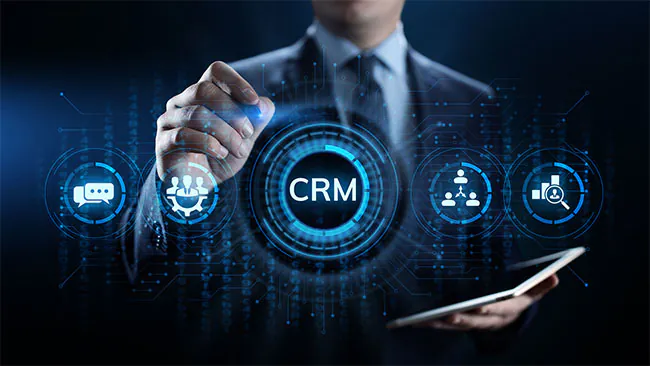Building a Customer Relationship Management (CRM) system from scratch is a major undertaking that can give your company a tailored solution for managing customer data and interactions.
The article is created by discovering the custom CRM development portfolio of Belitsoft, a software development firm with 20+ years of expertise in multiple industries and technologies. The company confirmed its reputation with a 4,9/5 score from clients on the most trustworthy B2B review platforms like Gartner, G2, and Goodfirms. Customers have collaborated with Belitsoft for 5 years on average. The company develops bespoke CRM solutions from scratch if clients’ requirements are unique and off-the-shelf CRM systems can not satisfy them. Also, Belitsoft provides clients with modernization and customization of their existing CRM software to enhance the core functionality with tailored features and to jump on the missing opportunities.
CRM Features and Integrations To Consider in 2025
Regardless of industry, modern CRMs share a set of must-have features and integration capabilities. In 2025, users expect a CRM to provide a 360° view of customers, streamline sales processes, and connect seamlessly with other tools. Core features and integrations include:
Contact & Account Management
A centralized database for all customer and prospect information. Users should be able to add and organize contacts (individuals) and accounts (organizations), log interactions, and easily retrieve history. This forms the foundation of a “single source of truth” about customers.
Integration Capabilities
- Two-way sync with email systems (Gmail, Outlook) and calendars. This allows emailing from the CRM, logging inbound/outbound emails to contact records, and scheduling meetings with context.
- Connect with marketing tools or platforms so that marketing leads and campaign interactions flow into the CRM. This ensures sales can see marketing touchpoints and vice versa.
- Integration with support ticketing or helpdesk software (Zendesk, Freshdesk, etc.) to give a full customer view. Sales or account managers can then see if a customer has open support issues.
- Sync with calendar apps (Google Calendar, Office 365) for scheduling and with team collaboration tools (Slack, Microsoft Teams) if possible, to receive notifications or updates.
- For some businesses, linking the CRM to invoicing or ERP systems (QuickBooks, SAP, etc.) is essential so sales can see customer financial status or order history.
- Depending on the industry, there may be other integrations (social media, e-commerce platform, etc.) required to centralize all relevant customer data.
Each integration should use secure APIs and adhere to best practices for data protection. The ability to integrate ensures your CRM complements your existing software ecosystem rather than duplicating functionality.
Lead and Opportunity Management
Tools to capture leads and track them through the sales funnel. The CRM should support qualifying leads, converting leads to opportunities/deals, and visualizing the sales pipeline stages. This includes pipeline management features to forecast revenue and identify bottlenecks in the sales process (how many deals are in each stage, etc.).
Activity and Task Management
Functionality to schedule and track tasks, calls, meetings, and follow-ups. Sales and support teams rely on reminders and to-do lists so nothing falls through the cracks. The CRM should log all activities and allow task assignment and tracking to completion, helping managers ensure timely customer follow-up.
Interaction Tracking & Communication Logs
The ability to record every customer interaction (emails, calls, meetings, chats) in the CRM timeline. This often involves integrating with communication tools (more below) so that emails or call notes automatically link to the contact’s record. A rep should quickly see what communications have occurred with a client to avoid duplication and stay informed.
These foundational features are considered standard in any reputable CRM by 2025. Ensuring your in-house CRM includes them will cover the universal needs of customer-facing teams in sales, marketing, and support. Additional specialized features can be built on top of this core to suit your unique business processes.
Workflow Automation, Reporting & Analytics, User Roles & Access Control and Mobile Access
CRM should automatically assign leads to sales reps, send follow-up emails after a meeting, or trigger alerts when a deal moves stages. Modern CRMs have predictive lead scoring or email sentiment analysis.
The CRM should allow managers to track KPIs – number of leads created, conversion rates, sales cycle length, win/loss reasons, and customer retention.
A permission system is required to control data access based on user roles (sales reps see only their accounts, managers see all). An admin interface should let you configure roles (admin, manager, standard user, etc.) and what each can view or edit.
In 2025, a CRM must be accessible on mobile devices via responsive web or a mobile app.
Team Structure and Skills Required
Building a CRM in-house is a headcount decision – and one that pulls from multiple teams, not just engineering.
Executive Sponsor (Project Champion)
The core structure starts with an executive who owns the project at the top – the person who signs the check, clears blockers, and reminds the rest of the org that this CRM isn’t “just a tool”. Without that voice, the work stalls mid-build and gets reduced to a backlog item in year two.
Project Manager / Product Manager
This person holds the roadmap, translates business goals into dev tickets, and keeps deadlines from dissolving. They keep the team on schedule, manage scope and budget, and act as a bridge between technical teams and business stakeholders.
Business Analyst (or Subject Matter Expert)
The analyst role – or SME – is the one that protects the build from turning into a template. They define what the system needs to do, not just what it needs to store. In leaner teams, the PM or a lead engineer takes this on, but the risk is that tech leads will over-index on what’s easy to build, not what’s needed in the field.
Developers (Frontend and Backend)
You’ll need developers – frontend for the UI, backend for the data and integrations. Sometimes that’s two people. Sometimes it’s six. The numbers flex with scope. But at a minimum, you need the people who can write the interfaces, wire up the database, and hook in the APIs. Full-stack devs can span roles.
UI/UX Designer
While not always a dedicated role on smaller projects, investing in UX design ensures higher user adoption. The designer creates wireframes or prototypes (using tools like Figma) so that the development team builds a CRM that is easy to navigate for sales and other users. One designer could be part-time or contract early in the project.
Quality Assurance (QA) / Test Engineer
QA specialists develop test plans and systematically test the CRM to catch bugs and usability issues before launch. They perform unit tests, integration tests, and facilitate user acceptance testing. In absence of dedicated QA, developers should allocate time for thorough testing. Given the importance of data integrity in a CRM, QA is vital (1 QA engineer or shared responsibility across devs if needed).
DevOps Engineer / IT Infrastructure
Handles deployment, cloud hosting, and environment management for the CRM. This role sets up continuous integration/continuous deployment (CI/CD) for smooth releases, configures servers or cloud services, implements data backups, and ensures proper security measures (SSL, firewalls). Often a backend developer can take on this role if they have DevOps skills (1 DevOps/IT specialist, at least part-time during deployment phase).
Technical Architect / Tech Lead
Designs the overall software architecture of the CRM, including database schema, integration approach, and scalability/security considerations. This person chooses the technology stack (e.g. deciding on a frontend framework and backend platform that fit the team’s skills) and sets coding standards. Often also a senior engineer who mentors the dev team (1 architect/lead developer).
Data Analyst (Optional)
If your CRM will involve heavy analytics or data migration from old systems, a data specialist can help map and clean data, set up reports, and ensure data quality. This role can also assist in defining KPIs to track once the CRM is live.
CRM Administrator (Post-Launch)
Once the system is live, you will need ongoing administration. This role may be fulfilled by an IT admin, a power user in the business (e.g. Sales Operations manager), or a rotating duty for one of the developers. The admin handles user account management, minor configuration changes, and first-line support for users. They also monitor usage and uptake (1 admin, could be a part-time role in addition to other duties).
Training & Change Management Lead
To ensure successful adoption, assign someone to develop training materials and guides for end-users. This could be a training specialist or simply the PM/BA taking on the task of scheduling training sessions and creating user documentation. Additionally, a change management specialist (often the PM or an HR partner) can help communicate changes and manage any organizational resistance to the new CRM (Role can be part-time, critical around rollout period).
Typical Team Size
For a mid-sized company building a CRM, a core development team of 5–8 people is common (including 1 PM, 3–5 developers, 1 designer, 1 QA). Smaller organizations may start with a leaner team (1 PM, 2 developers, 1 shared designer/QA) but should be prepared to augment with additional skills as needed.
Keep in mind that custom development requires significant resources – you will need a full team of specialists and cannot rely on a single developer wearing all hats for a project of this scope. In fact, one source notes that to build a robust CRM in-house, you often need“a complete team of developers, UX/UI designers, QA specialists, and a project manager.
Skill Sets
Ensure the team collectively has experience in your chosen tech stack (front-end and back-end frameworks) and in building enterprise applications. Experience with CRM or similar business systems is a plus. Key skills include database design, API integration, security best practices, and UI/UX design for data-heavy applications. Strong project management and communication skills are needed to keep stakeholders updated and the team coordinated.
Finally, decide early whether the work will be 100% in-house or if you will supplement with contractors or a development partner for certain aspects. Some companies choose to keep strategy and key development in-house but may outsource specific tasks (mobile app development or UI design, etc.) if their team lacks that expertise. The team structure should be tailored to your company’s size and the complexity of the CRM you’re building.
In-House Development or Outsourcing vs. No-Code/Low-Code Solutions – Disadvantages Comparison
When building a CRM for internal use, company leaders often face a choice: develop with an in-house or outsourced technical team writing custom code, or use a no-code/low-code platform to assemble a solution with minimal coding. Each approach has downsides to weigh. Below is a comparison of the key disadvantages of each approach:
Disadvantages of Full In-House Development
High Upfront and Ongoing Cost
Custom development is expensive. You must budget for developer salaries, infrastructure, and maintenance. And that does not include the ongoing cost of support, bug fixes, and enhancements post-launch. An in-house team also incurs overhead (benefits, training, turnover).
Longer Time to Market
Coding from scratch can take months for a fully functional CRM. This longer implementation period means delayed benefits – your sales team may operate without modern CRM capabilities while waiting. During development, the business may need interim solutions, and there’s a risk that requirements change by the time the system is ready.
Resource and Skill Demands
If your company’s core business isn’t software, it may be hard to recruit and retain the necessary talent. Lacking any key skill (say, security or UX design) can derail the project. You also need to dedicate internal team members’ time, pulling them away from other projects. Many small companies simply don’t have enough spare capacity or the right expertise on staff to execute a CRM project at the needed quality level.
Maintenance Burden
Once you build it, you own it. All software requires updates for bug fixes, security patches, and evolving business needs. With a commercial CRM, many of those updates come included from the vendor, but with an in-house CRM, your team must continuously maintain and improve the system. Changes to web browsers, operating systems, or integration APIs can break features and will require developer attention. This can strain your IT team over the long run. If key developers leave the company, there’s a risk of losing critical knowledge, making the CRM hard to update or troubleshoot.
User Training and Support Overheads
A custom system has no community forums or pre-built training materials. You will need to invest in training users and creating documentation from scratch. If employees run into issues or have usage questions, your internal team (or a designated CRM admin) must support them, since there’s no vendor support line to call. This can increase the total cost of ownership and requires setting aside time for user support especially during rollout.
Disadvantages of No-Code/Low-Code Solutions
Limited Customization and Flexibility
Low-code platforms provide predefined modules and workflows that may not cover every nuance of your business. If your processes are highly unique, you may hit a wall trying to adapt a no-code tool to fit. These platforms offer only limited options to develop custom features, so truly one-of-a-kind requirements may not be achievable. You may end up changing your business process to fit the tool, rather than vice versa, losing one key rationale for a custom CRM.
Scalability and Performance Constraints
A no-code solution that works for a small user base or simple use case may struggle as your company grows or your usage becomes more complex. Some no-code apps are not designed for high volumes of data or transactions. Scaling up can incur extra costs for infrastructure or platform tiers and even then performance can degrade under heavy load. If your CRM needs to expand, you may have to rebuild on a more robust platform later.
Vendor Lock-In and Lack of Ownership
With a no-code/low-code platform, you typically do not own the source code of your CRM. Your data sits in the platform’s proprietary database and the app logic is not easily transferable. If you become unhappy with the vendor or they increase prices, switching away can be extremely difficult (you may have to rebuild the CRM elsewhere from scratch). This lock-in is a major consideration – your long-term agility is tied to the vendor’s roadmap and reliability.
Integration Limitations
No-code platforms often provide plugins or connectors to popular services, but integrating with internal or less common systems can be challenging. If your company uses a legacy system or a niche tool that doesn’t have a ready-made connector, you may find the no-code platform cannot easily interface with it. Custom integration on such platforms, if possible, may negate the “no-code” benefit and require developer assistance or using APIs in a clunky way.
Many companies use a hybrid approach – start with a low-code platform to quickly stand up a basic CRM for immediate needs, while in parallel planning a long-term custom build for full flexibility. Alternatively, some build core custom features in-house but leverage low-code tools for peripheral functions or rapid prototyping. CEOs should consider the strategic importance of the CRM: if it’s a key competitive differentiator, investing in in-house development may be justified.
Security and Compliance Concerns
Low-code platforms come with tradeoffs that aren’t always obvious.
When you adopt a third-party low-code CRM, you’re accepting someone else’s security model, patch cycle, and compliance framework. You may not be able to specify data residency. And when the platform owns the infrastructure, your flexibility ends at their settings menu.
Maintenance Issues
Maintenance adds another wrinkle. Low-code tools manage their own updates. You don’t handle the patches – but you also don’t schedule them. And if your implementation includes workarounds or custom logic layered on top, you’ll still need developers to fix what the platform won’t.
About the Author:

Dmitry Baraishuk is a partner and Chief Innovation Officer at a software development company Belitsoft (a Noventiq company). He has been leading a department specializing in custom software development for 20 years. The department has hundreds of successful projects in such services as healthcare and finance IT consulting, AI software development, application modernization, cloud migration, data analytics implementation, and more for US-based startups and enterprises.





























